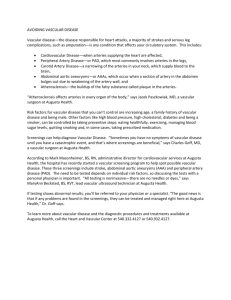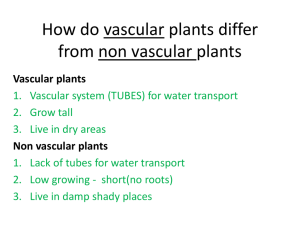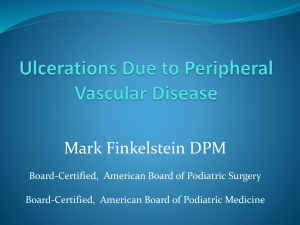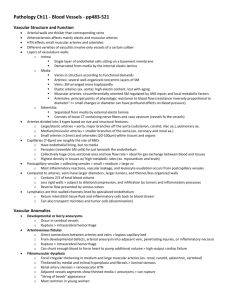New Concepts of Vascular and Vasogenic CNS Diseases
advertisement
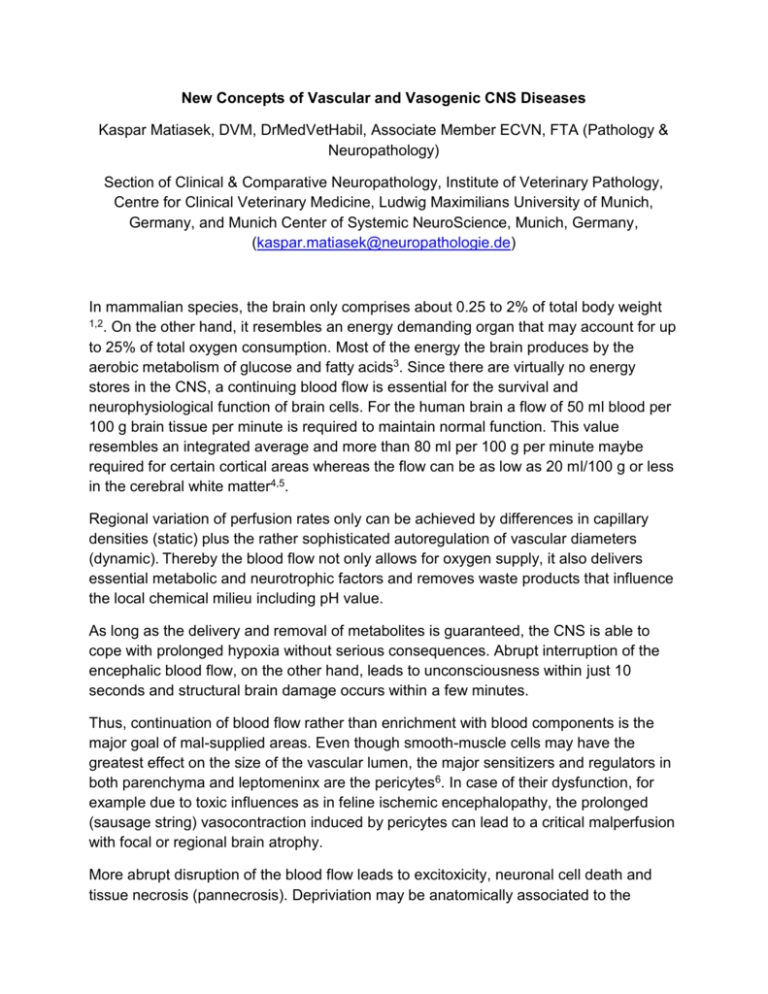
New Concepts of Vascular and Vasogenic CNS Diseases Kaspar Matiasek, DVM, DrMedVetHabil, Associate Member ECVN, FTA (Pathology & Neuropathology) Section of Clinical & Comparative Neuropathology, Institute of Veterinary Pathology, Centre for Clinical Veterinary Medicine, Ludwig Maximilians University of Munich, Germany, and Munich Center of Systemic NeuroScience, Munich, Germany, (kaspar.matiasek@neuropathologie.de) In mammalian species, the brain only comprises about 0.25 to 2% of total body weight 1,2. On the other hand, it resembles an energy demanding organ that may account for up to 25% of total oxygen consumption. Most of the energy the brain produces by the aerobic metabolism of glucose and fatty acids3. Since there are virtually no energy stores in the CNS, a continuing blood flow is essential for the survival and neurophysiological function of brain cells. For the human brain a flow of 50 ml blood per 100 g brain tissue per minute is required to maintain normal function. This value resembles an integrated average and more than 80 ml per 100 g per minute maybe required for certain cortical areas whereas the flow can be as low as 20 ml/100 g or less in the cerebral white matter4,5. Regional variation of perfusion rates only can be achieved by differences in capillary densities (static) plus the rather sophisticated autoregulation of vascular diameters (dynamic). Thereby the blood flow not only allows for oxygen supply, it also delivers essential metabolic and neurotrophic factors and removes waste products that influence the local chemical milieu including pH value. As long as the delivery and removal of metabolites is guaranteed, the CNS is able to cope with prolonged hypoxia without serious consequences. Abrupt interruption of the encephalic blood flow, on the other hand, leads to unconsciousness within just 10 seconds and structural brain damage occurs within a few minutes. Thus, continuation of blood flow rather than enrichment with blood components is the major goal of mal-supplied areas. Even though smooth-muscle cells may have the greatest effect on the size of the vascular lumen, the major sensitizers and regulators in both parenchyma and leptomeninx are the pericytes6. In case of their dysfunction, for example due to toxic influences as in feline ischemic encephalopathy, the prolonged (sausage string) vasocontraction induced by pericytes can lead to a critical malperfusion with focal or regional brain atrophy. More abrupt disruption of the blood flow leads to excitoxicity, neuronal cell death and tissue necrosis (pannecrosis). Depriviation may be anatomically associated to the leptomeningeal arterial system or deep penetrators and evoke territorial or lacunar infarcts, respectively. Notably, the tolerance to ischemia can be increased by hypoxemic preconditioning7. Global ischemia due cardiac arrest, intracranial pressure rise or large arterial occlusion evokes a bilateral lesion pattern that affects glutamatergic areas first and in subacute or chronic stages mimics metabolic/toxic encephalopathy or even neurodegeneration. On the other hand, mitochondrial encephalopathies and other non-circulatory disorders may incite “non-vascular infarcts” or infarct-like lesions that are histologically indistinguishable from true ischemic infarcts if they are confined to distinct vascular territories8,9. Hence, the pathologist not only needs to know the stage specific phenomenology of malperfusion, she or he also needs to be aware of the spatial hemispheric and interhemispheric distribution as well as of the vascular anatomy and the arterial blood flow characteristics of the respective animal species. All too often, algorithms for human brain diseases are employed without implementation of the appropriate species data. The same hold true for the evaluation of intracranial vasculopathies and hemodynamic disorders. Main determinants for the encephalic blood flow are (1) the systemic arterial pressure and (2) the intracranial resistance. The latter results from the intravasal lumen diameter and also the intracranial blood viscosity. The rheologic characteristics of the blood may be altered with microthrombi, in polycytemia or infection of red blood cells (e.g. Babesia canis)10,11. In these cases sludging impedes an appropriate vascular perfusion in certain grey matter areas. Associated changes usually are restricted to neuronal hyperexcitation and sometimes neuronal death without progression into pannecrosis. The intracranial blood pressure is about 10 mm Hg lower than the systemic blood pressure. With sustained elevation of the systemic blood pressure or an acute blood pressure crisis, the CNS can be subjected to the so-called Target Organ Damage which may involve arteries/arterioles and brain parenchyma. Cats appear to be most vulnerable to hypertensive angio-encephalopathy and present with a quite uniform lesion pattern involving vasculopathy, pervasive brain lesions, hemorrhage and infarcts. Thus, hypertension evokes changes by both malperfusion and breakdown of the blood brain barrier (B4). From a pathological point of view, B4 is most obvious in terms of vasogenic oedema. Thereby, increase of fluid is predominantly seen in the white matter while in the grey matter there is a rapid reabsorption of extracellular water by astrocytes. Water shifting is managed through an increased expression of water channel molecule aquaporin 412. In fact, aquaporin 4 immunohistochemistry may be the only option to visualize subacute vasogenic edema in the cortex. Consistent with the idea that in B4 there is an uncontrolled pass of molecules into the brain tissue, this chemical or immunological challenge can lead to a perivascular microglial activation and upregulation of detoxifying molecules such as LDL receptor, pglycoprotein and class B scavenger receptors13. In absence of concurrent vasculopathy, endothelial cells do not display histological signs that allow for an identification of B4. Physical damage of the vascular wall, on the other hand, is associated with regressive intramural changes, extravasation of macromolecules and hemorrhage. Rhexis and diabrosis resemble a severe disruption of the blood brain barrier even if they may be focal, only. Factors that weaken the vascular wall compliance are vasculitis, vasotoxic events and a large panel of media degenerations. As to whether vasculopathy leads to neurological complication very much depends on the localization and distribution of the event(s). Large vessel disease is likely to affect predominantly the leptomenigeal arteries. Disease scenarios here include hemorrhage and vascular stenosis. As a consequence to the breakdown of the vascular barrier (not B4!) in the subarachnoid space chemical changes induce vasospasm of small arteries and thereby superficial brain ischemia14. Narrowing of the large arteries may go unseen if the perfusion compromise is compensated by collateral meningeal arteries. The situation changes completely if it comes to the parenchymal vessels since they resemble functional end arteries and vascular territories are not overlapping. Moreover, vascular wall disruption directly exposes the nerve and glial cells to possibly neurotoxic blood components. Large vessel disease usually affects individual vascular segments and leads to focal or multifocal asymmetric brain lesions with often acute onset. Small vessel disease, in contrast, may be far more widespread, predominantly involves grey matter and hence leads to diffuse neurological complications. They may present again acutely with seizures but also with insidious neurocognitive decline. To associate the latter scenario to a certain neuropathological picture requires laborious algorithms and patience of the investigator. In particular the conclusion on incidental versus nosologically relevant role of these vascular changes is challenging. In summary, the unbiased investigation for vascular and circulatory disorders requires a two tiered algorithm and the availability of brain sections from all territories and main candidate areas from both sides of the brain. In the meninges, the focus is on the large and medium sized arteries. Interpretation of the relevance of vasculopathic features is only possible if the investigator is aware of the species-specific blood flow characteristics. The second stage is focused on the brain tissue and involves the appearance of the blood vessels, the perivascular parenchyma and the borders to neighboring territories including the watershed zones. In suspected subthreshold changes of the grey matter, special stains for astrocytes and hypoxic/lactic stress may be employed. References 1.Serendip.brynmawr.edu. 2003-03-07. "Brain and Body Size... and Intelligence". Retrieved 2011. 2. Kalimo H. Pathology & Genetics: Cerebrovascular Diseases. Basel: ISN Neuropath Press, 2005. 3. Panov A, Orynbayeva Z, Vavilin V, Lyakhovich V. Fatty acids in energy metabolism of the central nervous system. Biomed Res Int doi: 10.1155/2014/472459, 2014. 4. Auer RN, Sutherland GR. Chapter 5: Hypoxia and related conditions. In: Greenfield´s Neuropathology 7th ed. Graham DI, Lantos PL (eds). London: Arnold, 2002. 5. Li X, Sarkar SN, Purdy DE, Briggs RW. Quantifying cerebellum grey matter and white matter perfusion using pulsed arterial spin labeling. Biomed Res Int :108691, 2014. 6. Hall CN, Reynell C, Gesslein B, Hamilton NB, Mishra A, Sutherland BA, O'Farrell FM, Buchan AM, Lauritzen M, Attwell D. Capillary pericytes regulate cerebral blood flow in health and disease. Nature 508(7494):55-60, 2014. 7. Galle AA1, Jones NM. The neuroprotective actions of hypoxic preconditioning and postconditioning in a neonatal rat model of hypoxic-ischemic brain injury. Brain Res doi: 10.1016/j.brainres.2012.12.026, 2012. 8. Baiker K, Hofmann S, Fischer A, Gödde T, Medl S, Schmahl W, Bauer MF, Matiasek K. Leigh-like subacute necrotising encephalopathy in Yorkshire Terriers: neuropathological characterisation, respiratory chain activities and mitochondrial DNA. Acta Neuropathol 118(5):697-709, 2009. 9. Mizukami K, Sasaki M, Suzuki T, Shiraishi H, Koizumi J, Ohkoshi N, Ogata T, Mori N, Ban S, Kosaka K. Central nervous system changes in mitochondrial encephalomyopathy: light and electron microscopic study. Acta Neuropathol 83(4):4495, 1992. 10. Quesnel AD1, Parent JM, McDonell W, Percy D, Lumsden JH. Diagnostic evaluation of cats with seizure disorders: 30 cases (1991-1993). J Am Vet Med Assoc 210(1):6571, 1997. 11. Daste T, Lucas MN, Aumann M. Cerebral babesiosis and acute respiratory distress syndrome in a dog. J Vet Emerg Crit Care 23(6):615-23, 2013. 12. Stokum JA1, Kurland DB, Gerzanich V, Simard JM. Mechanisms of AstrocyteMediated Cerebral Edema. Neurochem Res [ahead of print], 2014 Jul 5. 13. Ueno M, Nakagawa T, Nagai Y, Nishi N, Kusaka T, Kanenishi K, Onodera M, Hosomi N, Huang C, Yokomise H, Tomimoto H, Sakamoto H. The expression of CD36 in vessels with blood-brain barrier impairment in a stroke-prone hypertensive model. Neuropathol Appl Neurobiol 37(7):727-37, 2011. 14. Cossu G, Messerer M, Oddo M, Daniel RT. To Look Beyond Vasospasm in Aneurysmal Subarachnoid Haemorrhage. Biomed Res Int: 628597. Epub 2014 May 19.


